2018 年浙江宁波大学二外英语考研真题
Part I Cloze Test (20 points, 1 point each)
Directions: In this part you are required to read the given passages carefully, and
then fill in each blank with an appropriate word given in the boxes. Each word is
allowed to be used only once. You should not change the form of the word but you
can capitalize the initial letter if the word is used at the beginning of the sentence.
Write your choices in the Answer Sheet.
Passage One
as
basically
because
between
unlike
whatever
where
which
while
who
1
Living in a culture that is different from your own can be both an exciting and
challenging experience. You have to learn different cultural practices and try to
adapt to them. Here are the top six cultural differences
China and the US
to help promote mutual understanding.
Chinese people do not have the same concept of privacy as Americans do. They talk
about topics such as ages, income or marital status,
Americans think is
annoying and intrusive.
In China, elders are traditionally treated with enormous respect and dignity
3
the young are cherished and nurtured. In America, the goal of the family is to
encourage independence, particularly that of the children.
the Chinese, older
Americans seldom live with their children.
Chinese people have different meanings to define friends. Just hanging out together
time to time is not friendship. Friendship means lifelong friends who feel deeply
obligated to give each other
help might seem required. Americans always call
people they meet friends, so the definition of friends is general and different.
There are work friends, playing friends, school friends and drinking friends.
2
4
5
6
is well known, the Chinese like to save. They are always conservative when
they are planning to spend money. It is different in the USA,
far fewer
families are saving money for emergencies and education than their Chinese
counterparts.
Chinese people value education and career more than Americans,
more emphasis on good character and faith.
in turn put
7
8
9
China values the community and the US values the individual. If you achieve
something in the US, it's because you were great. While in China, if you achieve
something in China it's
the team, or family, or the company is great.
Everything you do gets attributed to the greater whole, while in America individual
merits are celebrated.
10
Passage Two
allocate
businesses
develop
ease
efforts
�
preferenti
al
pressure
released
rights
unidentified
11
China’s transportation regulator issued guidelines on Thursday to improve
management of the burgeoning car-sharing industry.
The government encourages car-sharing, which allows people to rent cars for short
periods of time and can help
,
according to the guidelines
by the Ministry of Transport, which are open
for public comment for two weeks.
Car-sharing vehicles should register with public security bodies, pass several tests
and be insured. They should not be leased to
Enterprises that run car-sharing
information and are encouraged to work with insurers to
products to protect their legal
14
should protect users' private
specific insurance
urban congestion and parking
and those of their users.
users.
12
13
15
16
17
18
should be made to
19
car-sharing vehicles in line with public demand,
parking policies,
20
urban road networks and parking areas, as well as to offer
according to the guidelines.
China is home to more than 40 car-sharing firms, which own more than 40,000 cars,
most of which are new energy vehicles.
Part II Reading Comprehension (40 points)
Section A (10 points, 1 point each)
Directions: In this section, there is a passage with ten blanks. You are required
to select one word for each blank from a list of choices given in a word bank following
the passage. Write your choices in the Answer Sheet.
1
a buzz with guests.
Weddings can cost a fortune and for a young couple it can create debt that can haunt
newlyweds for several years, but the hottest trend in food could be just the answer
to help lower the cost of the big day and
According to social media platform Pinterest, the site has seen a 30 percent
2
in food trucks being used at weddings. The idea seems a bit out there, but when
evaluating the cost and the possible variety of good eats, it makes
sense.
Reports have the average cost per person of $60 or more just for a few appetizers
and a catered dinner, but the cost of using a truck is just $20, a savings of $4,000
based on 100 guests. The savings isn't the only
as these meals on wheels also
give guests more
and likely a meal that comes out hot and juicy, not
precooked and warmed hours afterwards.
Food Revolt did a terrific article on the subject and
6
three trucks can create a menu that fits any theme,
7
gluten free, vegetarian,
tropical, or just good old fashion BBQ, though the latter isn't best when wearing
an expensive white gown.
For those cold night, hot food ideas will keep everyone warm and the
going
at full speed. Warm nights and guests can be served cooler dishes with the idea of
that using two or
3
4
8
5
�
9
and for those partying late
keeping all the people at your big day more
into the night, some nice greasy food is perfect when the alcohol level is a bit
high.
Food trucks have become the rage in big cities and for good reason. Hot food, good
service, and a terrific variety of dishes makes everyone happy and for the lucky
couple, it could help save years of
with a more affordable way of feeding
family and friends by keeping the finances in check.
10
A)
B)
C)
D)
E)
F)
G)
H)
positive
pointed
create
comfortable
considering
perfect
obstacle
suggested
I)
J)
K)
L)
options
outstanding
including
distress
M)
increase
N)
O)
luxuries
reception
Section B (30 points, 2 points each)
Directions: There are 3 passages in this section. Each passage is followed by some
questions or unfinished statements. For each of them there are four choices marked
A, B, C and D. You should decide on the best choice and put it in the Answer Sheet.
Passage One
Questions 1 to 5 are based on the following passage.
A new study by US researchers suggests that the ocean, in particular the epic ebbs
and flows of sea level and sediment(沉积) over the course of geological time, is
the primary cause of the world’s periodic mass extinctions over the past 500 million
years.
“The expansion and contractions of those environments have pretty profound effects
on life on earth,” says assistant professor of geology and geophysics at the
University of Wisconsin-Madison, who is the author of the new report published in
the latest issue of the journal Nature.
In short, says the professor, changes in ocean environments related to sea level
exert a driving influence on rates of extinction, which animals and plants survive
or vanish, and generally determine the composition (结构)of life in the oceans.
Since the advent of life on Earth 3.5 billion years ago, scientists think there may
have been as many as 23 mass extinction events. During the past 540 million years,
there have been five well-documented mass extinctions, primarily of marine plants
and animals, with as many as 75~ 95 percent of species lost.
For the most part, scientists have been unable to pin down the causes of such dramatic
events. In the case of the disappearance of the dinosaurs, scientists have a smoking
gun, an impact crater (火山口) that suggests dinosaurs were wiped out as the result
of a large asteroid (行星)crashing into the planet. But the causes of other mass
�
extinction events have been murky(模糊的), at best.
Arnold Miller, a professor of geology at the University of Cincinnati, says the new
study is striking because it establishes a clear relationship between the tempo of
mass extinction events and changes in sea level and sediment.
The new Wisconsin study, Peters says, does not preclude other influence upon
extinction such as physical events like volcanic eruptions or killer asteroids, or
biological influences such as disease and competition among species. But what it
does do, he argues, is to provide a common link for mass extinction events over a
significant stretch of Earth history.
B) Flows of sea level.
D) Periodic mass extinctions.
1. What does the phrase “those environments” refer to in the beginning of the second
paragraph?
A) Ocean environments.
C) Sediment.
2. According to the passage, most of the mass extinctions are ________.
B) results of natural processes
A) well-known to scientists
C) closely related to volcanoes
D) not well-recorded
3. It can be inferred from the passage that ___________.
A) scientists have found out the causes of most mass extinctions
B) the causes of most mass extinctions are still unknown to scientists
C) most mass extinctions happen much faster than people have expected
D) people’s damage to the environment contributes greatly to mass extinctions
4. The new study is quite impressive as it________.
A) has conducted a convincing experiment into the causes of mass extinctions
B) suggests the causes of mass extinctions and the changes of ocean environments
C) excludes other influences exerted on mass extinctions ever known
D) involves both physical and biological influences on mass extinctions
5. According to the passage, the author’s attitude is ________.
A) negative
C)positive
B)critical
D)indifferent
Passage Two
Questions 6 to 10 are based on the following passage.
The houses and businesses in Osage, a town of some 3,600 people in northern Iowa,
seem just like buildings anywhere else in small-town America. Only a close look
reveals the difference. Examine, for example, the new insulated roof on the local
hospital that shaves utility bills 20%. Or venture into the basement of Steele’s
Super Valu grocery to see the wall that owner Everett Steele built around his cooling
compressors to capture heat, which is then pumped into the store. Osage’s model
conservation program saved the town an estimated $1.2 million in energy costs in
1988 and made a modest but worthwhile contribution toward slowing down global
warming.
The folks in Osage save energy in the old-fashioned way: they plug leaky windows,
�
insulate walls and ceilings, replace in efficient furnaces and wrap hot-water
heaters in blanket insulation. Since 1974, the community has cut its natural-gas
consumption some 45% and reduced its annual growth in electricity demand by more
than half, to less than 3% a year.
Much of the town’s energy saving can be traced to the zeal of Weston Birdsall,
general manager of Osage Municipal Utilities. Looking back to 1972, when he took
over the utility company, Birdsall recalls, "That’s about the time OPEC reared its
ugly head. We had to do something. “Birdsall preached conservation door to door,
offering to give every building a free thermogram, a test that pinpoints places where
the most heat is escaping. More than half the town’s property owners accepted the
offer.
Birdsall’ s conservation campaign still flourishes long after similar efforts
elsewhere have flagged. The utility recently decided to give customers $15
fluorescent light bulbs (荧光灯), which use far less energy than incandescent models
(白炽灯). While Birdsall’s strategies are based on simple, widely known techniques,
few cities or towns apply the methods as diligently as Osage does. "Why aren’t more
people doing this?" Birdsall asks. Maybe more of them will if they come to realize
that conserving energy not only saves money but also helps save the environment.
6. The difference between the buildings in Osage and the rest of the country is that
building in Osage ________.
A) have newly insulated roof
B) have no leaky windows or doors
C) use hot-water heaters instead of furnaces
D) adopt some kind of energy-saving method
7. The energy saving program in Osage is _________.
A) modern
C) costly
B) traditional
D) complicated
8. What stimulated Birdsall to launch this energy saving campaign in Osage?
A) Pressure from OPEC.
B) Increasing energy consumption.
C) Environmental problems.
D) Desire to do better in his new post.
9. Which of the following best describes Birdsall’s personality?
A) Talkative.
C) Persistent.
B) Intelligent.
D) Thrifty.
10. Which of the following statements might be inferred from the passage?
A) Fluorescent light bulbs are more popular than incandescent models in the US now.
B) Osage’s conservation program helps prevent global warming.
C) More and more cities are adopting Osage’s energy saving methods.
D) Many Americans still don’t realize the importance of energy conservation.
Passage Three
Questions 11 to 15 are based on the following passage.
One of the most remarkable things about babies is that, even before they’re forming
�
sentences, they’re starting to mentally map out the structure of their worlds,
separating people and things into conceptual groups. Psychologists call this process
“categorization,” and it’s why if you bring a one-year-old to the zoo, they don’t
call an aardvark a ball, they call it a dog — it has four legs and a snout, after
all.
Toddler categorization is even more sophisticated than their word choice might
indicate. This is put into special light in a new study in the Proceedings of the
National Academy of Sciences, where Cornell assistant professor Katherine Kinzler
and her colleagues found that one-year-olds can see the links between people’s
identities and the foods they like. Over several experiments, the researchers
brought 200 one-year-olds into the lab and tracked their gazes, which developmental
psychologists take to be a proxy(代替物)for what babies are thinking about. Like
when you see someone very hot or very strange on the subway, toddlers can’t help
but stare at what they’re thinking about, and they’re more likely to focus on things
that surprise them. The researchers used this pattern to infer babies’ expectations:
If they saw someone hate a food that someone else said they loved, they’d look longer,
since it was so novel.
Writing about the experiments in the New York Times, Kinzler relates further
fascinating findings: If the people in the videos acted like they hated each other
the tots thought that they’d like to eat different things, while if they acted
friendly, the babies thought they’d like the same foods. Family background seems
to play a big role, too: Kids from families who spoke only English thought that if
two people spoke different languages, they’d like different foods, while kids from
bilingual households thought that people speaking different languages might like
the same things to eat. “It was as if cultural lines were being drawn right in the
laboratory,” Kinzler writes. “And in the babies’ minds there seemed to be
something special about the link between culture and food: When the babies saw people
liking and disliking inedible objects, we didn’t observe the same patterns of
results.”
It’s further evidence of how parents shape patterns of cognition in kids: Well
before they can tell their parents about it, children are receiving a worldview
through their families. So if you want your kids to eat (and probably live) broadly,
model it for them. If your friends have boring taste, blame their parents.
11. We know from the first paragraph that one-year-old babies ________.
A) like dogs more than any other animals
B) can classify things by their appearance
C)can construct simple sentences
D) are interested in the mental world
12. Which of the following can prove one-year-olds’ classification is more
sophisticated than their word choice might indicate?
A) Because they can reveal their expectations to their parents in a simple way.
B) Because they can find out what are the strangest thing in the crowded subway.
C) Because they can relate an aardvark with a dog on the basis of their legs and
snout.
�
D) Because they can find out the relationship between foods and people’s identities.
13. If one driver says he doesn’t like the favorite cake of the one-year-olds, they
might ________.
A) look at the driver for a long time
B) turn to their parents for help
C) refuse to touch the cake any more
D) throw the cake away with anger
14. The word fascinating (L1, Para. 3) most probably means ________.
A) rational
C) influential
15. What is the main idea of the third paragraph?
A) Bilingual education should be carried out as early as possible.
B) One should not show his dislike for food in children’s presence.
C) One-year-olds usually think in term of food.
D) Family education is crucial to babies’ cognition.
D) convincing
B)attractive
(10 points, 1 point each)
Part III Word Formation
Directions: Fill in each blank with the correct form of the word given at the end
of each sentence and write your answers in the Answer Sheet.
1. I was too _________ in my own problems and too uninterested in politics to remember
that it was also a momentous day in Washington. (absorb)
2. There is a great deal of _________ about how the system works. (confuse)
3. She is an actress whose inner life has remained ________, despite the many
interviews she has given. (mystery)
4. He was dragged from his van and beaten ________ by his opponents. (conscious)
5. The physical world was and still is indifferent to the mathematicians’ ________.
(classify)
6. Doctors yesterday delivered an overwhelming vote of no confidence in _________
health service shake-ups. (controversy)
7. It was the team’s third ________ defeat and their fourth defeat in five matches.
(succeed)
8. Teaching off a blackboard is boring, and ________ turns people off. (doubt)
9. It may be difficult to do at first. Don't let this ________ you.(courage)
10. There has been no ________ to his remarks from the government. (respond)
Part IV Translation (15 points, 5 points each)
Directions: In this part you are required to translate the given sentences into
English and you should write your translation in the Answer Sheet.
1.虽然上世纪取得了人类历史上最伟大的科学成就,但科学家们相信本世纪还会取得更大的
成功。
2.在一个现代化的城市里,要避免交通阻塞绝非易事。也许一个良好的地铁系统是减轻交通
阻塞的唯一有效方法,可是建设成本十分高。
3.中国的改革开放政策引起了社会经济结构的巨大变化,结果使得国民经济大大发展,人民
的生活水平大幅度提高。
�
Part V Writing (15 points)
Directions: In this part you are required to write a composition of no less than
160 words on the basis of the following information:
Do you agree or disagree with the following statement? University students should
be required to take up at least one course that teaches them the culture of a foreign
country. Use specific reasons and examples to support your answer.
�
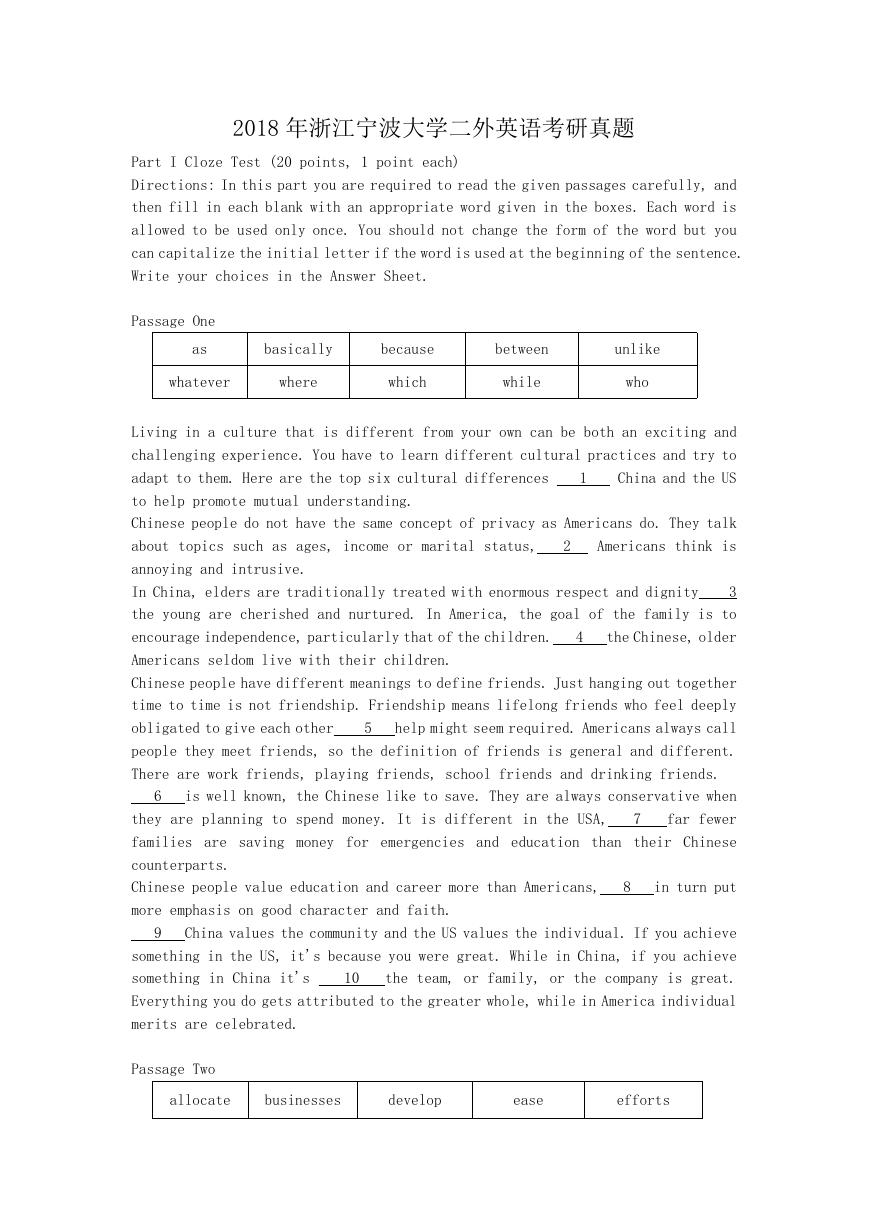
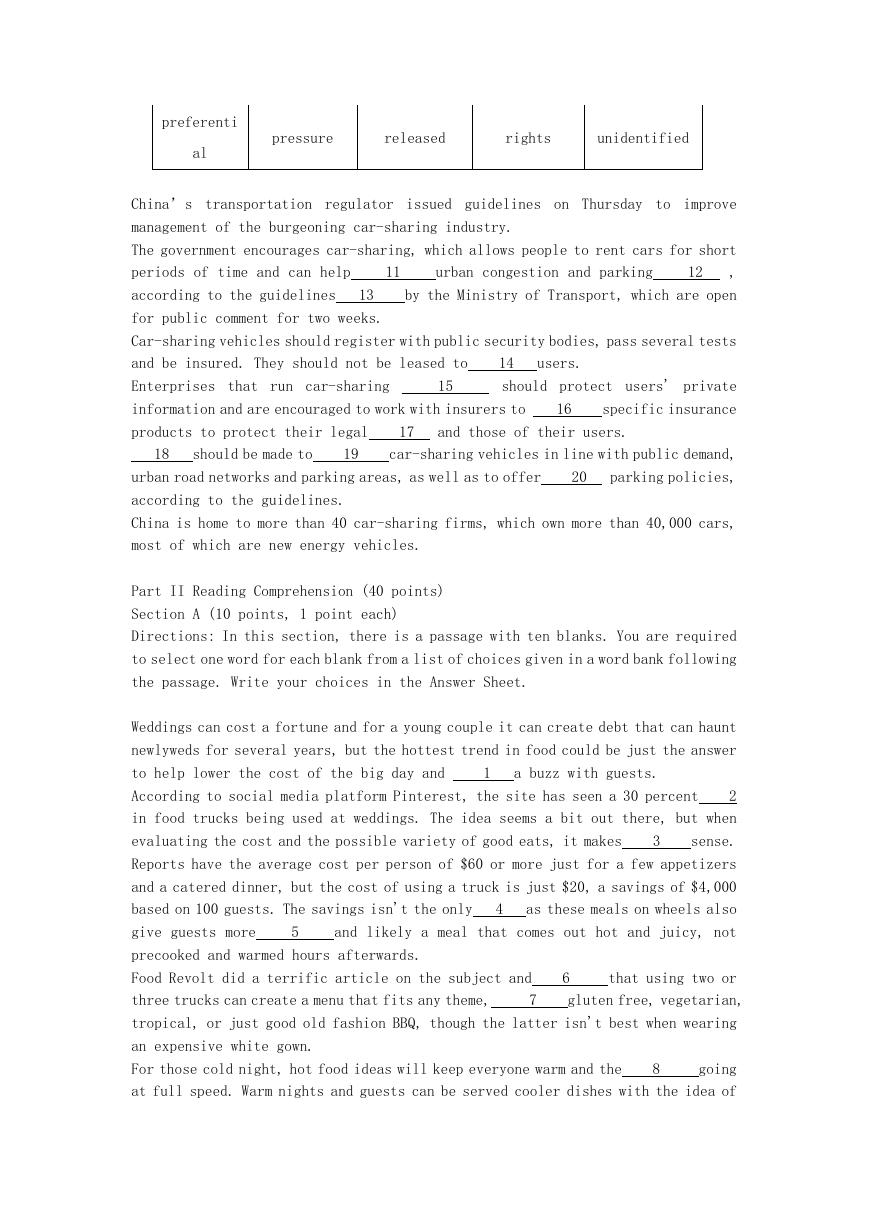
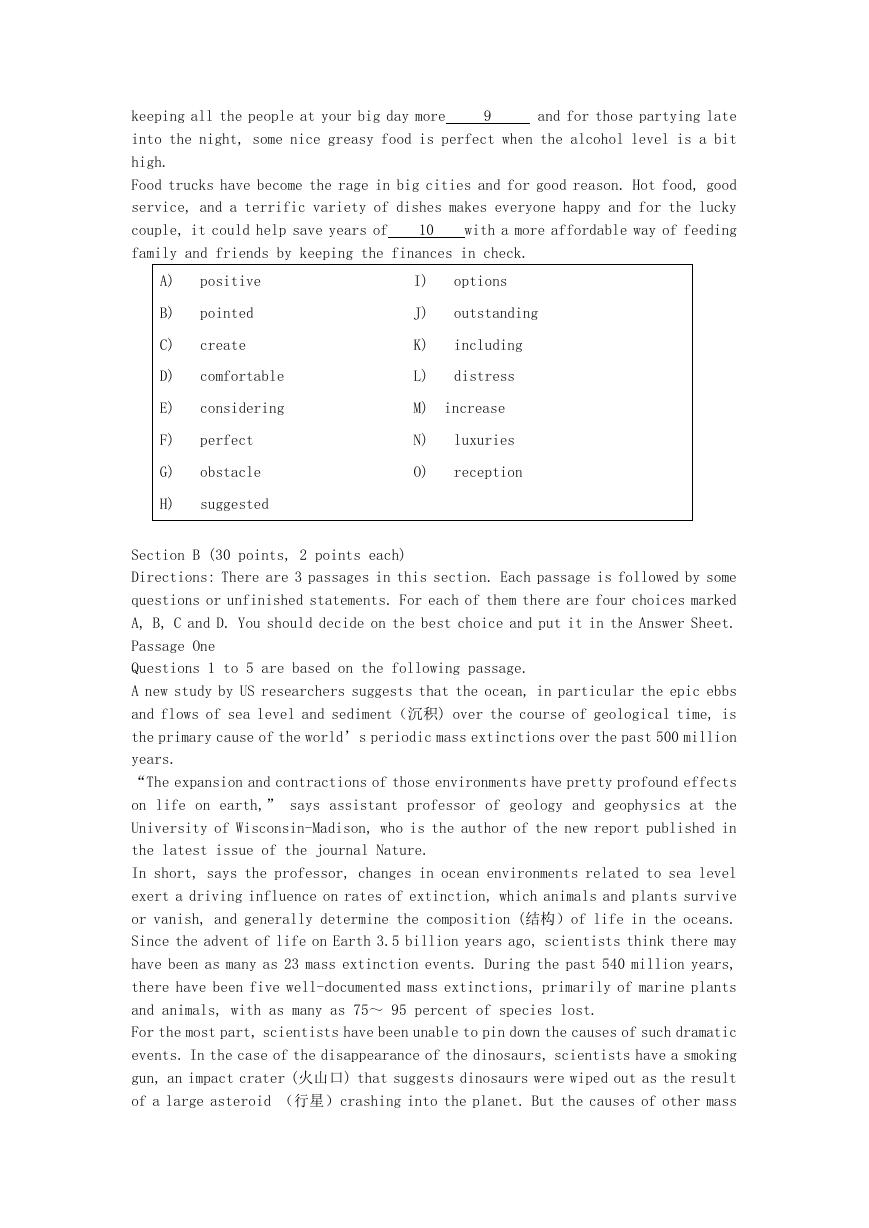

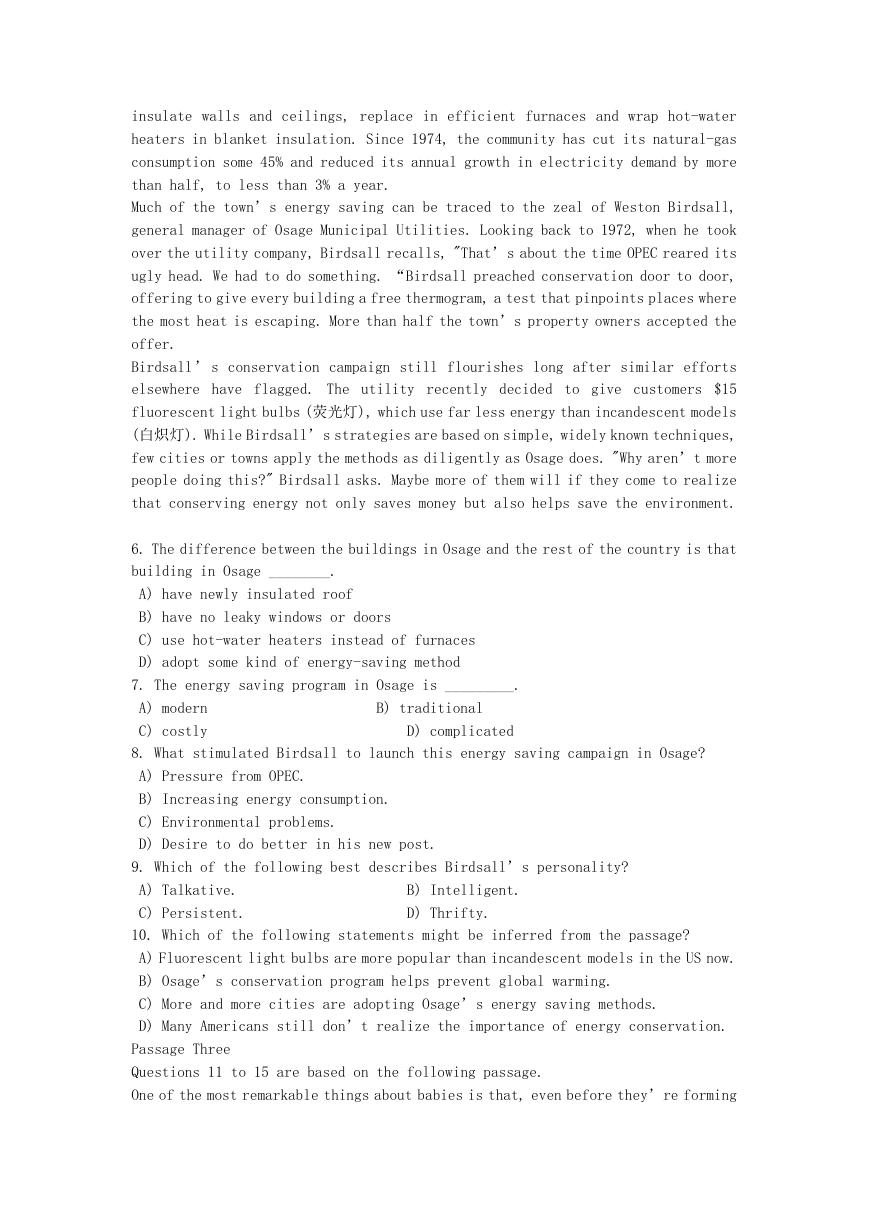
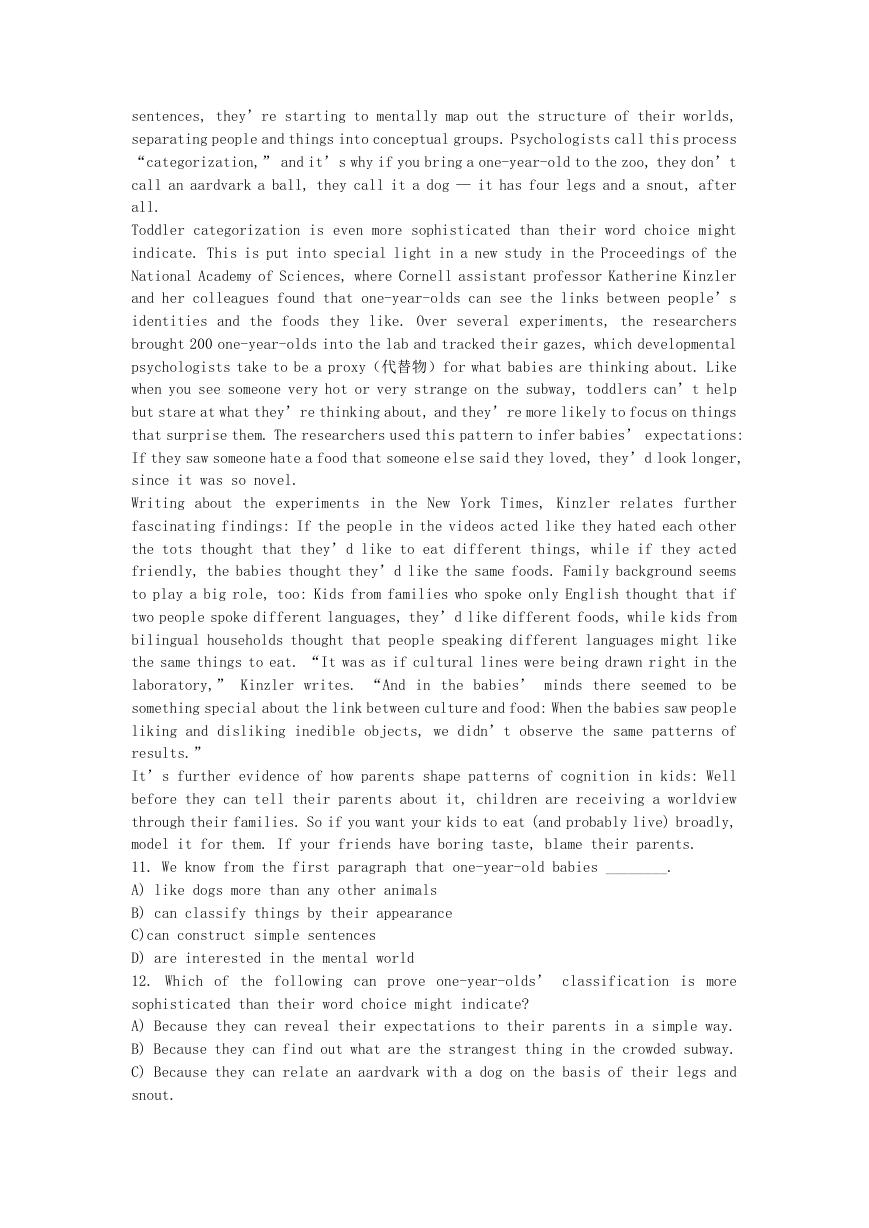










 2023年江西萍乡中考道德与法治真题及答案.doc
2023年江西萍乡中考道德与法治真题及答案.doc 2012年重庆南川中考生物真题及答案.doc
2012年重庆南川中考生物真题及答案.doc 2013年江西师范大学地理学综合及文艺理论基础考研真题.doc
2013年江西师范大学地理学综合及文艺理论基础考研真题.doc 2020年四川甘孜小升初语文真题及答案I卷.doc
2020年四川甘孜小升初语文真题及答案I卷.doc 2020年注册岩土工程师专业基础考试真题及答案.doc
2020年注册岩土工程师专业基础考试真题及答案.doc 2023-2024学年福建省厦门市九年级上学期数学月考试题及答案.doc
2023-2024学年福建省厦门市九年级上学期数学月考试题及答案.doc 2021-2022学年辽宁省沈阳市大东区九年级上学期语文期末试题及答案.doc
2021-2022学年辽宁省沈阳市大东区九年级上学期语文期末试题及答案.doc 2022-2023学年北京东城区初三第一学期物理期末试卷及答案.doc
2022-2023学年北京东城区初三第一学期物理期末试卷及答案.doc 2018上半年江西教师资格初中地理学科知识与教学能力真题及答案.doc
2018上半年江西教师资格初中地理学科知识与教学能力真题及答案.doc 2012年河北国家公务员申论考试真题及答案-省级.doc
2012年河北国家公务员申论考试真题及答案-省级.doc 2020-2021学年江苏省扬州市江都区邵樊片九年级上学期数学第一次质量检测试题及答案.doc
2020-2021学年江苏省扬州市江都区邵樊片九年级上学期数学第一次质量检测试题及答案.doc 2022下半年黑龙江教师资格证中学综合素质真题及答案.doc
2022下半年黑龙江教师资格证中学综合素质真题及答案.doc